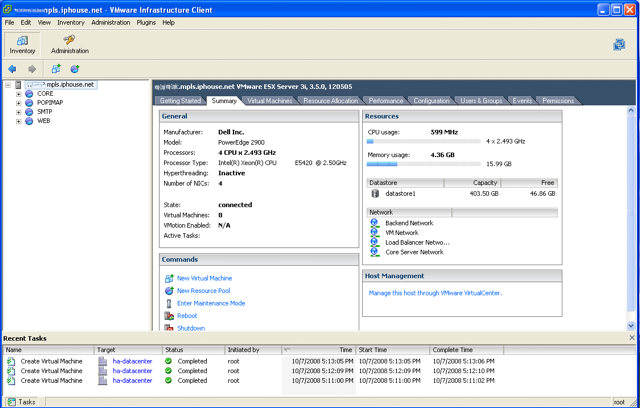Oh noes, part 3 is upon me and now I must be witty or informative. I am tired today, so I’ll try for informative.
My PE2900 showed up today and has been put into the rack. I even have a silly picture of its guts…

Wasn’t that nice? Say ‘yes’ please, it helps my ego a lot.
Now onto the virtualization ghetto tour!
I am using VMware ESXi for internal hosting of servers. And before you ask, no, there will not be any virtual servers set up for any third party clients, the EULA is quite clear on that topic.
Initial resource configurations have been put into place:
Yah, not very visible, but that’s okay. You’ll notice (if it is readable enough) that I have 8 virtual systems configured already, but in reality I am only working on 2 for the moment.
I plan on having 8 of these servers to compress (to start) 22 of the servers in the data center today, so the load will be spread out. This is a proof of concept period – will services be upgraded, while at the same time save me power? That is what I am trying to prove.
First is a test web server running FreeBSD 7.x, amd64, Apache, PHP, and the supporting application installs to make it all work.
Second is a test POP and IMAP server running FreeBSD 7.x, amd64, Courier-IMAP (for now), Dovecot (can’t wait to deploy this), and any supporting application installs to make it work. There isn’t much extra stuff thankfully.
The other 6 virtual systems configured are as for core services (like DNS resolvers, authoritative DNS servers, slave authentication servers) and for the actual SMTP workload (frontend, delivery, outbound), these 6 systems will be brought online when I can continue to load the server down without impacting performance.
I will be measuring CPU lag (very hard to do, but when you have been a geekadministrator as long as I have been, you start to feel how a system should operate, how it feels under your fingers, typing, etc. So this will be very subjective.
I’ll also be measuring I/O capabilities, disk throughput, network throughput as well. These measurements will use tools for that are easy to use, and even informative. Tools like iostat, vmstat, netstat (for FreeBSD), the other operating systems will use different tools.
For this week, I will NOT be doing any kind of tuning of ESXi, I am trying to do apples to apples comparison of the workloads I am considering for this type of platform. There are a lot of tuning how-to sites, and information via the VMware forums about how to best tune your system for this or that. Right now, I have too much ‘this or that’ to start futzing with it. Later I will delve deeper into the tuning of ESXi.
I’ll get part 3.1 out soon as I get things going, and provide some evidence to power utilization, performance (both subjective and objective), and more screenshots.
For later parts, I will also be working with other operating systems starting with Linux kernel based Ubuntu and ending with Sun Solaris (either full Solaris or OpenSolaris).
